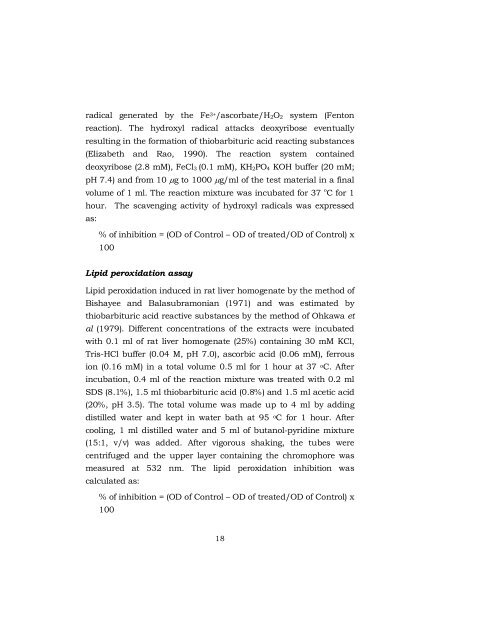Qualitative and quantitative analysis of biologically active principles ...
Qualitative and quantitative analysis of biologically active principles ...
Qualitative and quantitative analysis of biologically active principles ...
Create successful ePaper yourself
Turn your PDF publications into a flip-book with our unique Google optimized e-Paper software.
adical generated by the Fe 3+ /ascorbate/H 2O 2 system (Fenton<br />
reaction). The hydroxyl radical attacks deoxyribose eventually<br />
resulting in the formation <strong>of</strong> thiobarbituric acid reacting substances<br />
(Elizabeth <strong>and</strong> Rao, 1990). The reaction system contained<br />
deoxyribose (2.8 mM), FeCl 3 (0.1 mM), KH 2PO 4 KOH buffer (20 mM;<br />
pH 7.4) <strong>and</strong> from 10 mg to 1000 mg/ml <strong>of</strong> the test material in a final<br />
volume <strong>of</strong> 1 ml. The reaction mixture was incubated for 37 o C for 1<br />
hour. The scavenging activity <strong>of</strong> hydroxyl radicals was expressed<br />
as:<br />
% <strong>of</strong> inhibition = (OD <strong>of</strong> Control – OD <strong>of</strong> treated/OD <strong>of</strong> Control) x<br />
100<br />
Lipid peroxidation assay<br />
Lipid peroxidation induced in rat liver homogenate by the method <strong>of</strong><br />
Bishayee <strong>and</strong> Balasubramonian (1971) <strong>and</strong> was estimated by<br />
thiobarbituric acid re<strong>active</strong> substances by the method <strong>of</strong> Ohkawa et<br />
al (1979). Different concentrations <strong>of</strong> the extracts were incubated<br />
with 0.1 ml <strong>of</strong> rat liver homogenate (25%) containing 30 mM KCl,<br />
TrisHCl buffer (0.04 M, pH 7.0), ascorbic acid (0.06 mM), ferrous<br />
ion (0.16 mM) in a total volume 0.5 ml for 1 hour at 37 o C. After<br />
incubation, 0.4 ml <strong>of</strong> the reaction mixture was treated with 0.2 ml<br />
SDS (8.1%), 1.5 ml thiobarbituric acid (0.8%) <strong>and</strong> 1.5 ml acetic acid<br />
(20%, pH 3.5). The total volume was made up to 4 ml by adding<br />
distilled water <strong>and</strong> kept in water bath at 95 o C for 1 hour. After<br />
cooling, 1 ml distilled water <strong>and</strong> 5 ml <strong>of</strong> butanolpyridine mixture<br />
(15:1, v/v) was added. After vigorous shaking, the tubes were<br />
centrifuged <strong>and</strong> the upper layer containing the chromophore was<br />
measured at 532 nm. The lipid peroxidation inhibition was<br />
calculated as:<br />
% <strong>of</strong> inhibition = (OD <strong>of</strong> Control – OD <strong>of</strong> treated/OD <strong>of</strong> Control) x<br />
100<br />
18

















